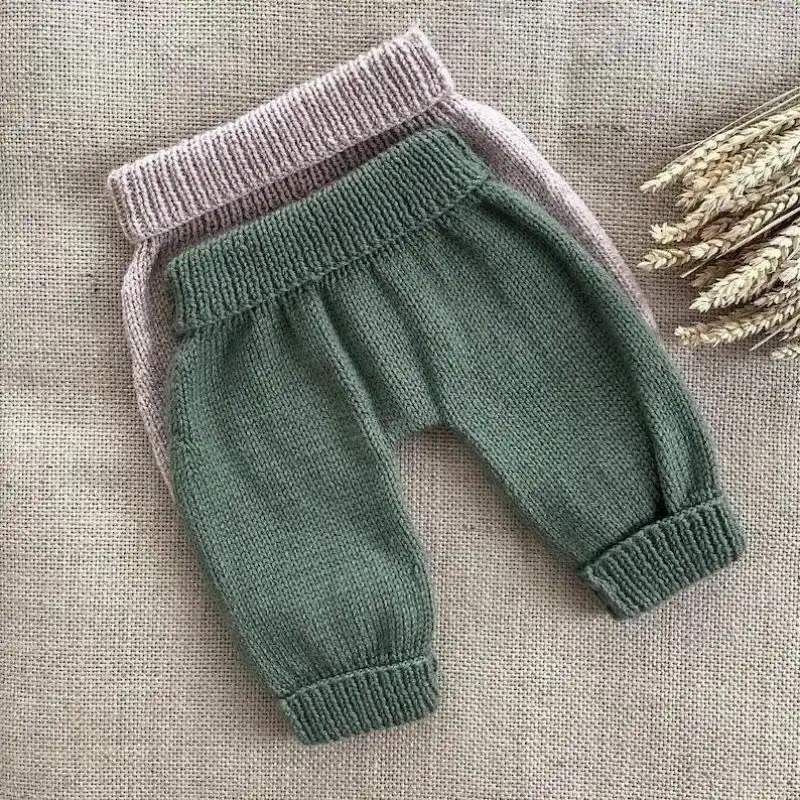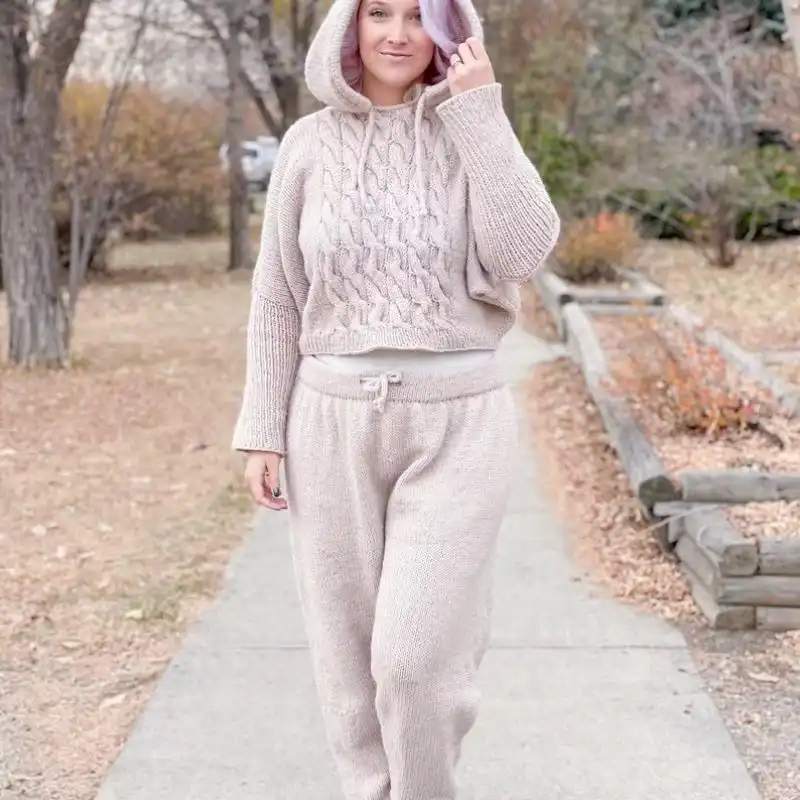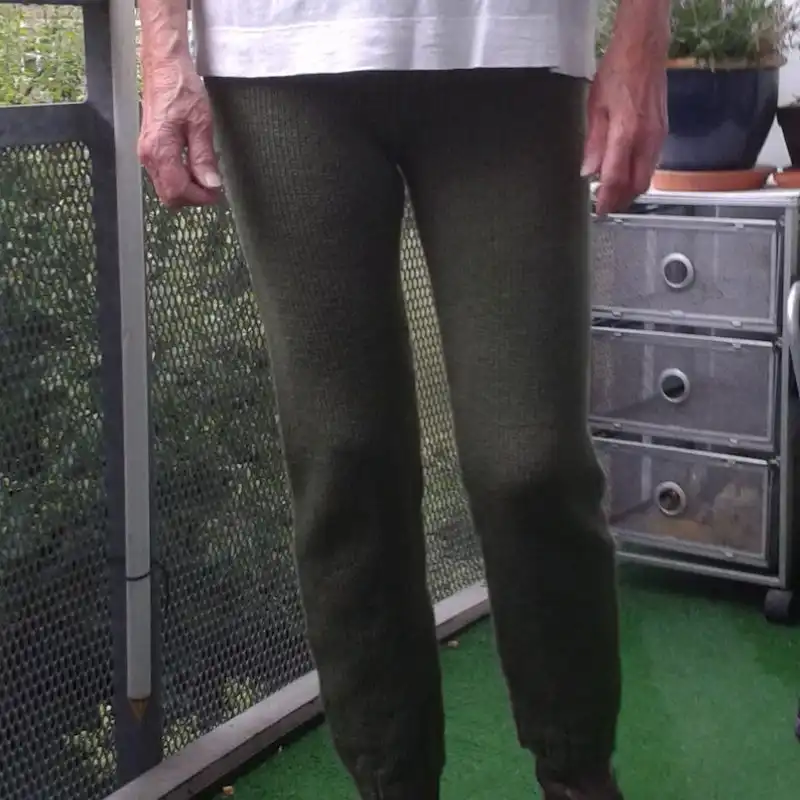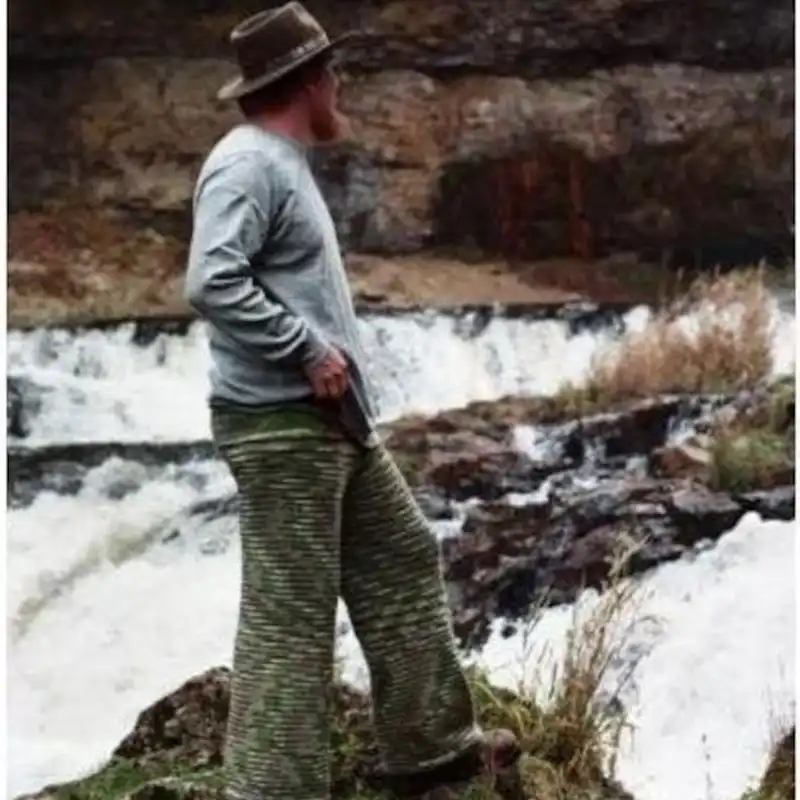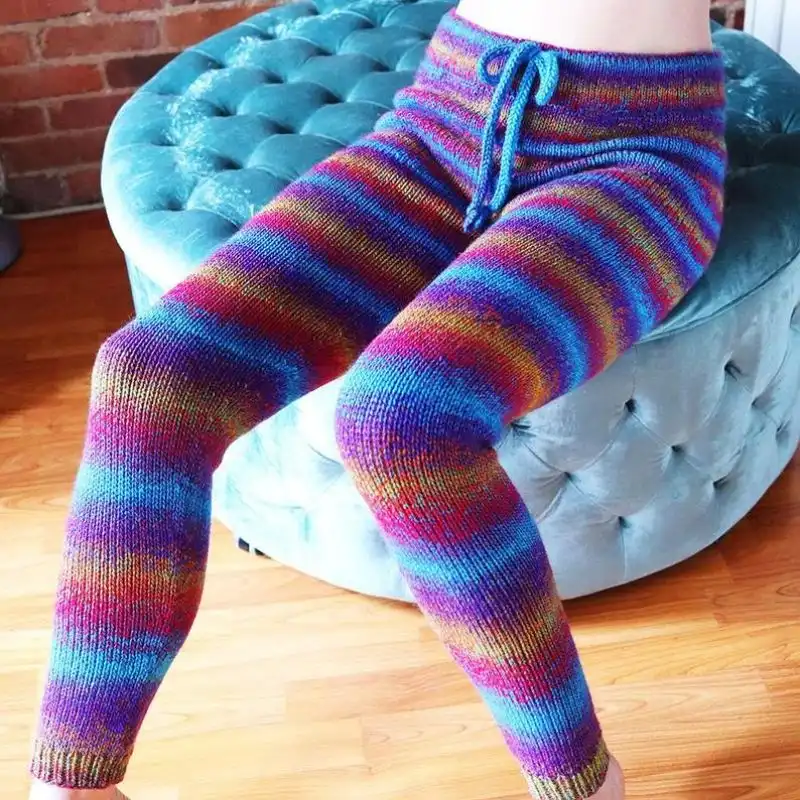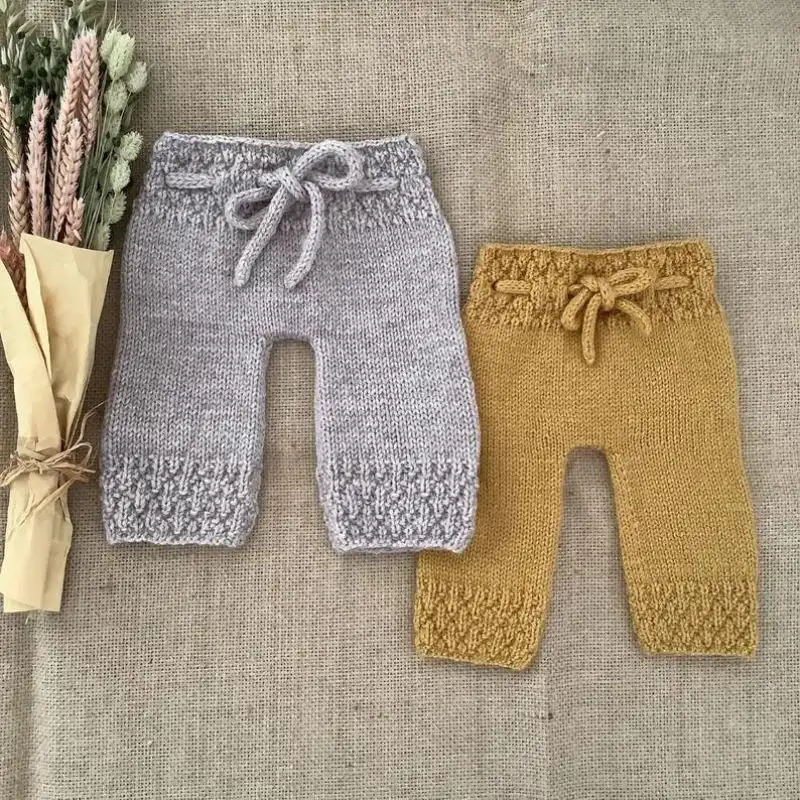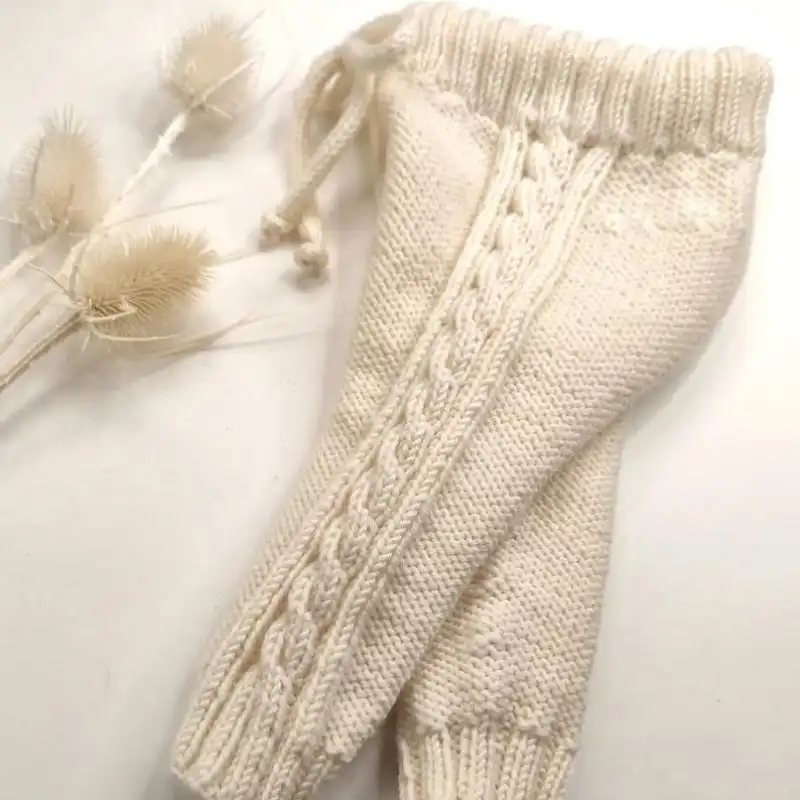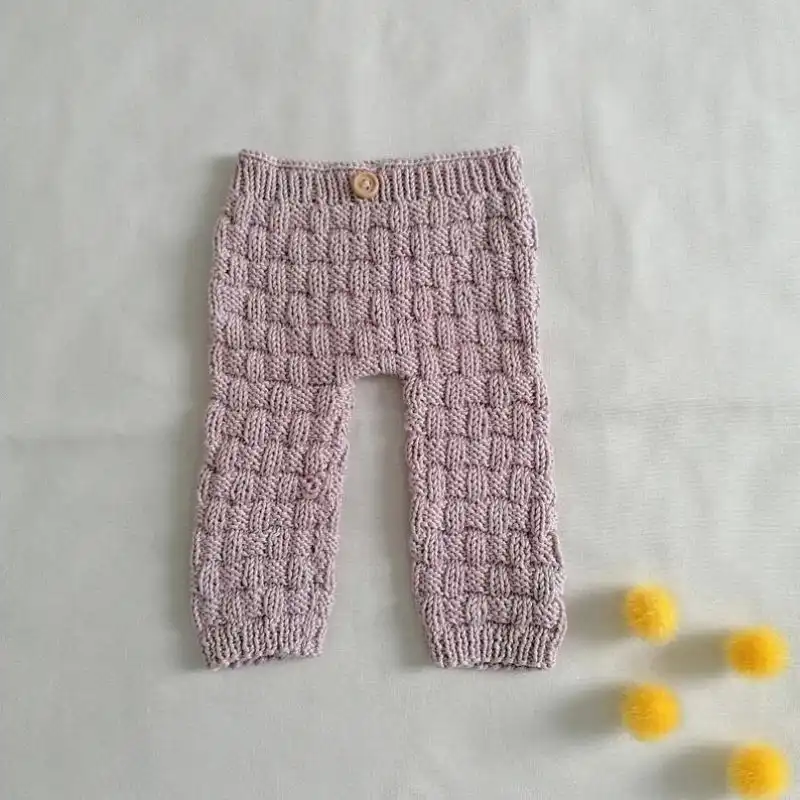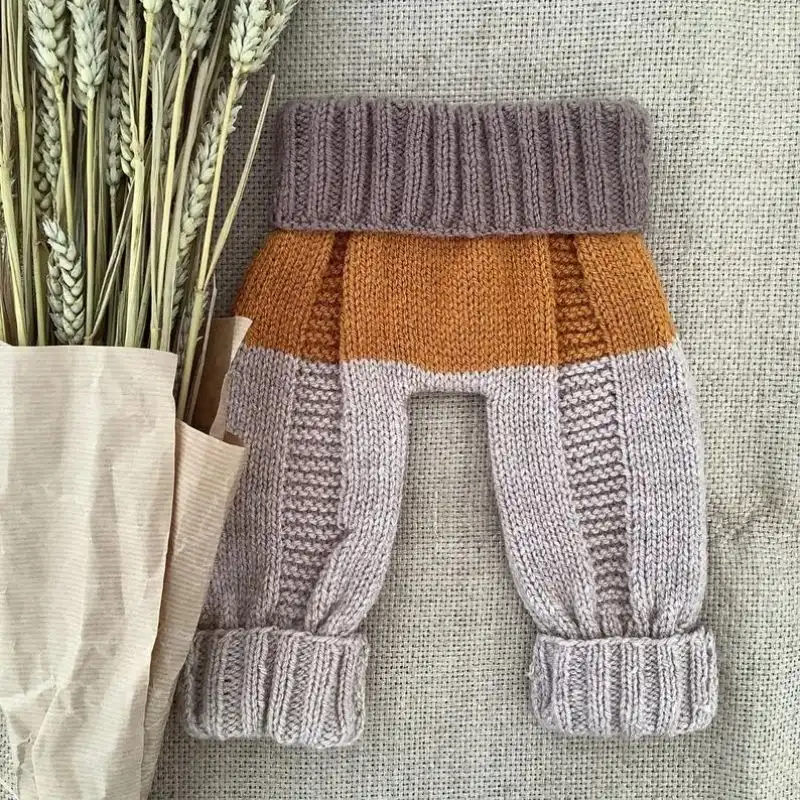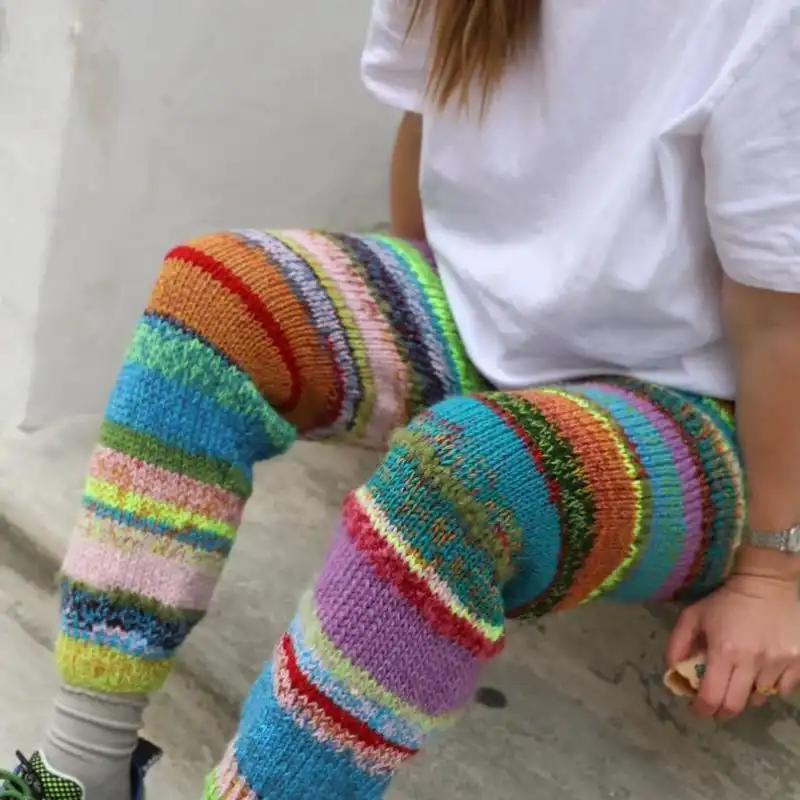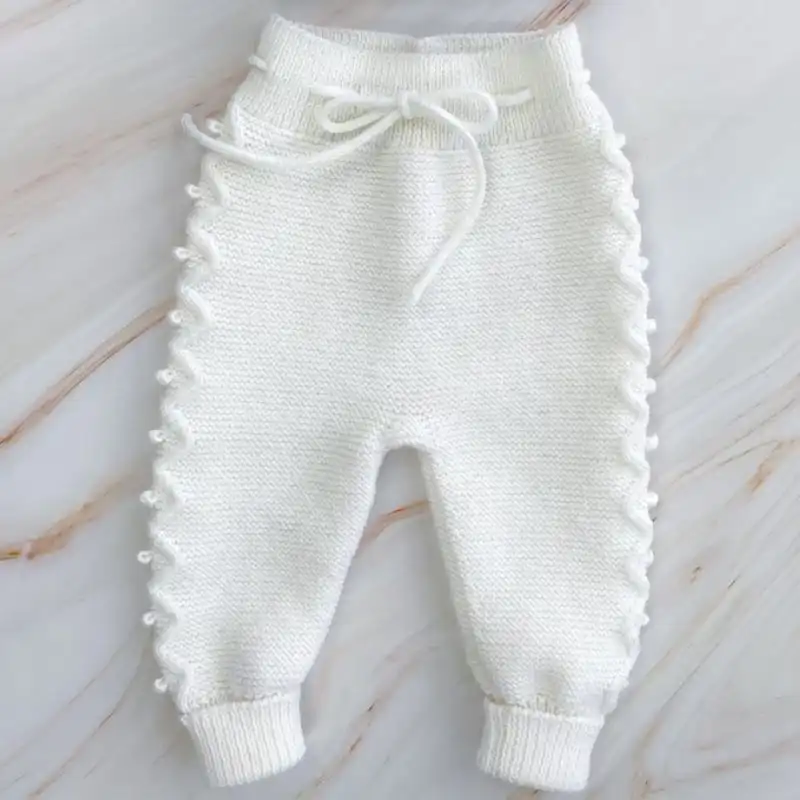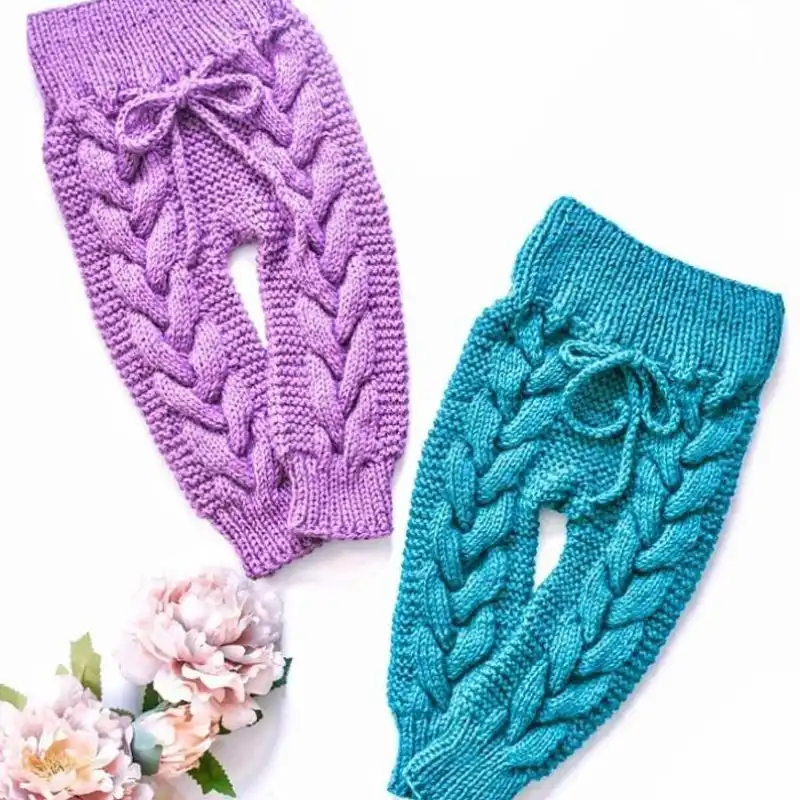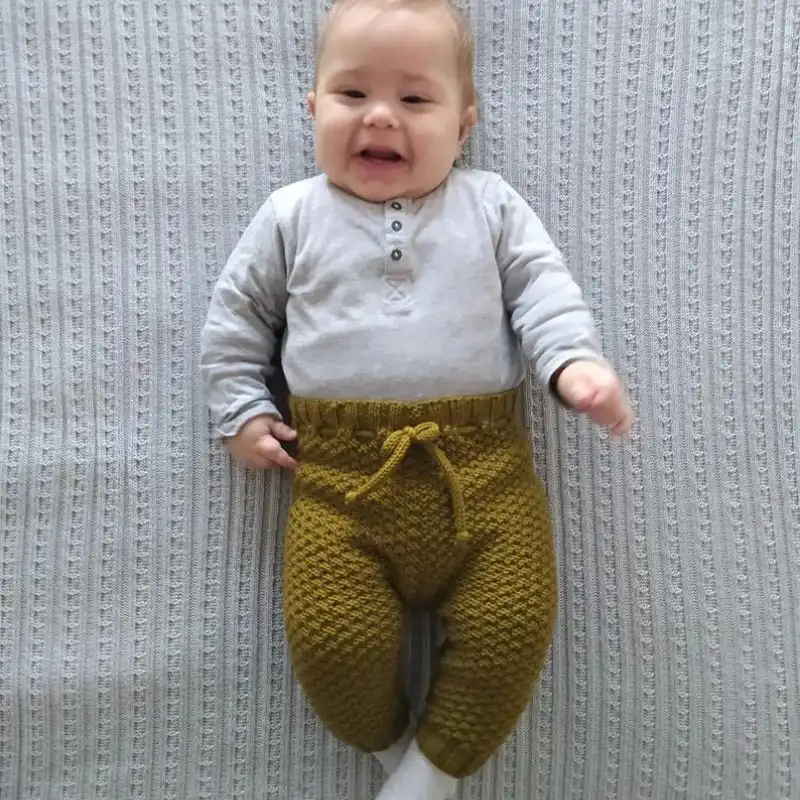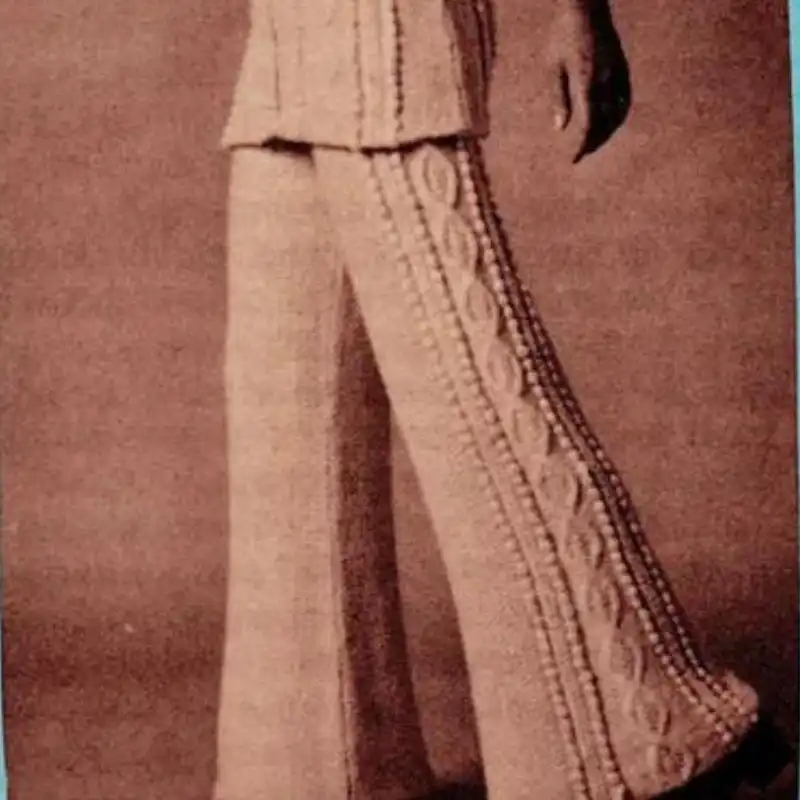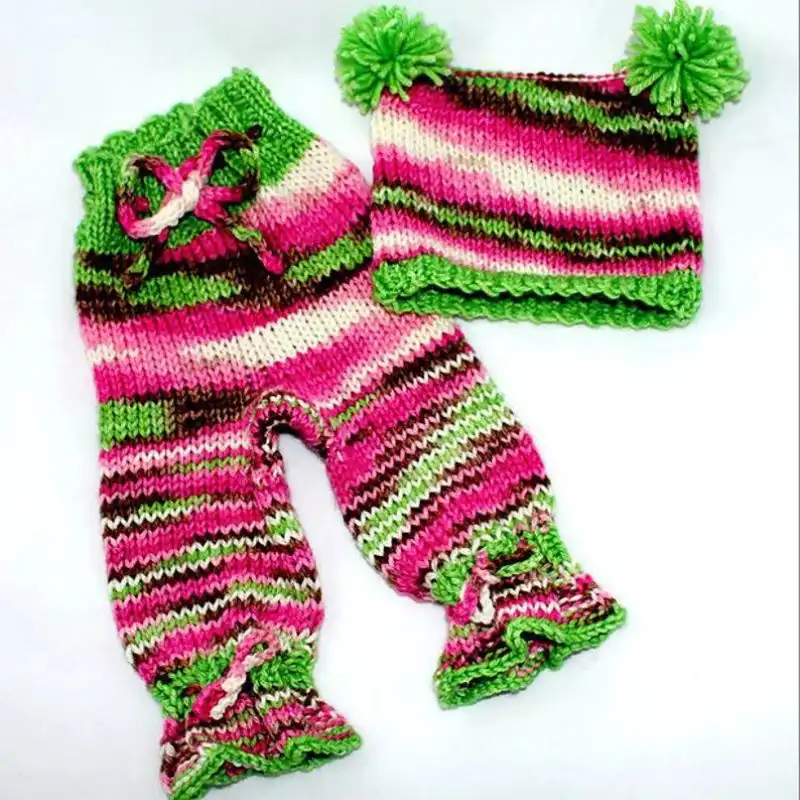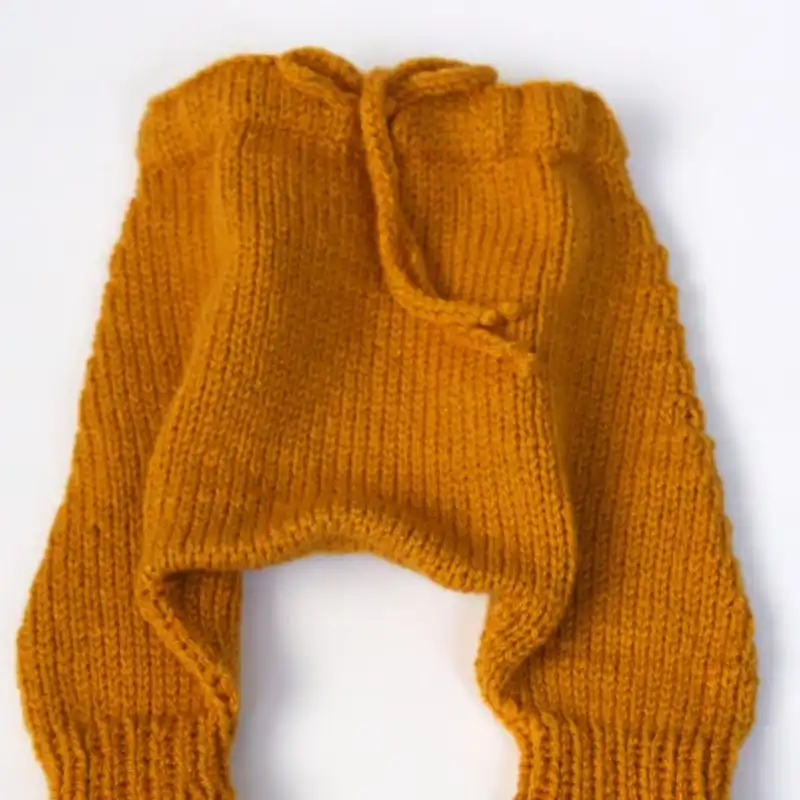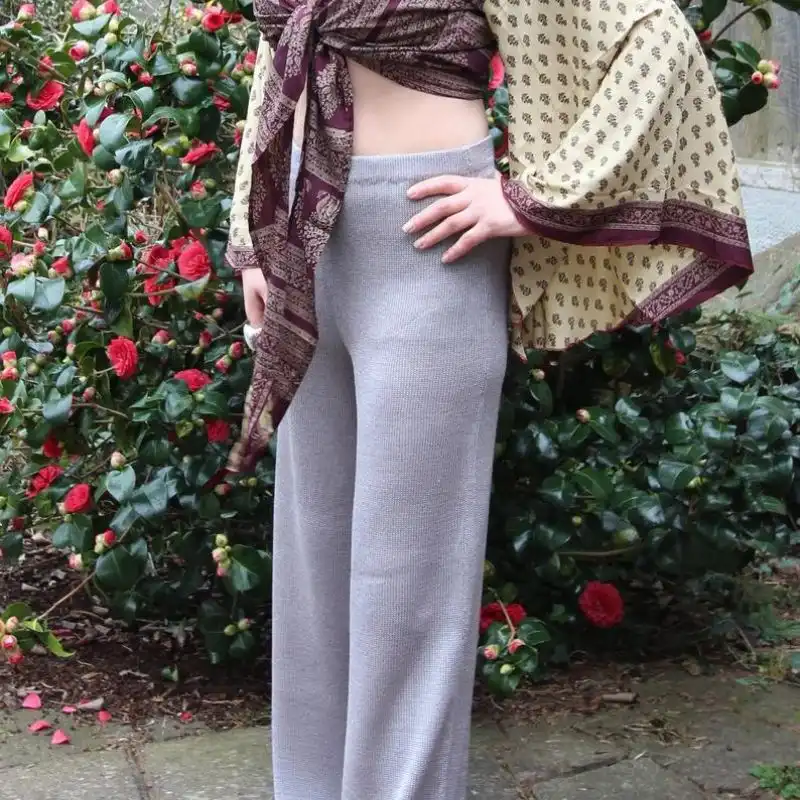Have you ever faced the dilemma of finding the perfect pair of stylish and cozy pants? I’ve been there, and as an expert knitter, I’ve discovered the best way to solve this problem. Knitting your pants!

It’s one of the easiest and most rewarding projects you can undertake. Today, I’m thrilled to share 25 Free Pants Knitting Patterns that blend warmth with fashion.
These patterns are my top picks and some of the simplest to follow, making them an excellent option for knitters of all levels. There’s something for everyone, from chunky, snug designs to sleek, chic styles. The most significant advantage of knitting your pants is the customization – you’ll never have to compromise on fit or style again.
All you need are your needles, yarn, and enthusiasm. So, let’s jump in and explore these patterns. Your best bet for staying stylishly warm this season is at your fingertips!
Overview Of Popularity & Versatility Of Knitted Pants
Knitted pants have surged in popularity recently, emerging as a staple in fashion and DIY crafting circles. This rise in appeal is attributed to their unique blend of comfort, style, and personalization. Here’s an overview of the reasons behind their popularity and versatility:
- Comfort And Coziness: Knitted pants are synonymous with comfort. Made from soft yarns, they provide a coziness that is hard to find in other materials. This comfort factor makes them a popular choice for loungewear, especially in cooler climates.
- Fashion Forward: With the growing trend of mixing comfort with style, knitted pants have entered mainstream fashion. Designers are experimenting with various knitting patterns and yarn types, creating pieces that range from casual to high-fashion.
- Customizability: One of the greatest appeals of knitted pants is the ability to customize. Knitters can choose from various colors, textures, and patterns, allowing for a level of personalization that isn’t possible with off-the-rack clothing.
- DIY Trend: The rise of DIY culture, especially in crafting communities, has bolstered the popularity of knitted pants. Knitting enthusiasts enjoy the challenge and satisfaction of creating something functional and fashionable from scratch.\
- Versatility In Styles: Knitted pants are not limited to one style or silhouette. They can range from fitted leggings to loose, flowing culottes, catering to various tastes and body types.
- Seasonal Flexibility: While typically associated with colder weather, knitted pants can be made from lighter yarns for warmer seasons. This versatility makes them a year-round garment choice.
- Sustainable Fashion: As more people lean towards sustainable and ethical fashion choices, knitting your pants offers a way to engage in this movement. It provides an option to use eco-friendly and ethically sourced materials.
- Therapeutic Crafting: Beyond the fashion aspect, knitting is often seen as a therapeutic hobby. The process of creating knitted pants provides a relaxing and rewarding experience.
Various Stitches To Knit A Pant
Knitting pants involve a variety of stitches, each contributing to the texture, elasticity, and overall design of the garment. Here’s a list of various stitches you might use while knitting pants, along with an explanation of each:
- Stockinette Stitch: This is the most basic knitting stitch, characterized by smooth ‘V’s on one side and purl bumps on the other. It’s often used for the main body of the pants, providing a classic, smooth finish.
- Rib Stitch: Ribbing is commonly used for waistbands and cuffs of knitted pants. It’s elastic and form-fitting, created by alternating knit and purl stitches. The most common rib patterns are 1×1 (k1, p1) and 2×2 (k2, p2).
- Garter Stitch: This stitch is made by knitting every row when working flat or alternating a row of knit and a row of purl in the round. It’s stretchy and doesn’t curl, making it suitable for details like drawstrings or decorative bands.
- Seed Stitch: A textured pattern created by alternating knit and purl stitches within the same row and then reversing the order in the next row. It gives a bumpy texture and is often used for decorative panels or accents.
- Cable Stitch: Cables add a twist or braid-like texture and are often used for decorative elements on the sides or along the legs of the pants. They can range from simple twists to intricate, interlocking designs.
- Moss Stitch: Similar to the seed stitch, the moss stitch provides a more deeply textured, bumpy surface. A sequence of knit and purl stitches creates a checkerboard-like effect.
- Slip Stitch: This involves passing a stitch from the left needle to the right needle without knitting it. Slip stitches can create exciting textures or color patterns in the fabric.
- Lace Stitch: While less common in pants, lace stitches can be used for lightweight, breathable summer pants. These stitches involve yarn overs and decreases to create open, decorative patterns.
- Twisted Rib Stitch: This is a variation of the rib stitch where you knit through the back loop. It results in a more defined, tighter rib pattern and is excellent for waistbands or cuffs that need extra elasticity.
- Basketweave Stitch: This stitch creates a checkerboard texture similar to a woven basket. It’s a combination of blocks of knit and purl stitches, giving a nice texture to the fabric.
RELATED: 43 Chunky Scarf Knitting Patterns With Effortless Style And Cozy Warmth
How Long A Pant Should Be?
When knitting pants, the length of the garment is crucial for ensuring a proper fit and comfort. The length of pants can vary significantly depending on the style and the wearer’s measurements. Here’s a discussion on various sizes and how to determine the appropriate length for knitted pants:
- Infants And Toddlers: For the youngest wearers, pants lengths vary significantly as they increase. Typically, pants for infants can range from 7 inches (for newborns) to around 14 inches (for 24-month-olds). It’s essential to check measurements as infants proliferate frequently.
- Children: For children, pants lengths can range from about 16 inches for a two-year-old to around 26 inches for pre-teens. Again, frequent measurement checks are essential due to growth spurts.
- Teens And Adults: This category sees the most variation in pants lengths. Generally, the inseam measurement (the length from the crotch to the ankle) is used. For average adult women, inseam lengths usually range from 28 to 32 inches, while for men, they can be 30 to 36 inches. However, these are average ranges, and individual measurements can vary widely.
- Petite And Tall Sizes: Petite sizes typically have shorter inseam lengths (about 2 to 4 inches shorter than regular sizes), while tall sizes have longer inseams (about 2 to 4 inches longer).
- Plus Sizes: For plus-size pants, the inseam length might be similar to regular sizes, but the fit around the hips, waist, and thighs is adjusted for a fuller figure.
- Custom Sizing: One advantage of knitting your pants is the ability to customize the length based on the wearer’s specific measurements. To determine the ideal length, measure the inseam from the crotch to the desired length at the ankle or foot, depending on the style.
- Style Considerations: The desired length also depends on the style of the pants. For instance, capri pants are shorter, ending around the mid-calf, while full-length trousers go down to the ankle. High-waisted pants might also affect the length, as the starting point of measurement might be higher.
- Allowance For Shrinkage Or Stretching: In knitting, it’s essential to account for the potential shrinkage or stretching of the yarn. Some yarns, especially natural fibers, might shrink after washing, while others stretch with wear.
Essential Tools And Materials
Knitting a pair of pants requires a collection of essential tools and materials to ensure the project is successful and enjoyable. Here’s a list of what you’ll need:
Abbreviations For Knitting Pants
When knitting pants or any knitting project, you’ll encounter a variety of abbreviations in patterns. These abbreviations help simplify and condense instructions. Here’s a list of standard knitting abbreviations that you might find in a pattern for knitting pants:
- CO: Cast On – To start by creating the initial stitches on the needle.
- BO: Bind Off – Securing the stitches to close off your work.
- K: Knit – The basic knitting stitch.
- P: Purl – The reverse of the knit stitch.
- St(s): Stitch(es) – The individual loop(s) of yarn that you work into.
- K2tog: Knit Two Together is a primary decrease method that turns two stitches into one.
- P2tog: Purl Two Together – Similar to K2tog, but with purl stitches.
- SSK: Slip, Slip, Knit – Another decrease method that leans to the left.
- YO: Yarn Over – An increase method that also creates a small hole, often used in lace patterns.
- M1: Make One – An increase method that creates a new stitch.
- Sl: Slip – To move a stitch from one needle to another without working it.
- PM: Place Marker – To put a stitch marker on the needle.
- SM: Slip Marker – Move the marker from the left needle to the right.
- Rep: Repeat – To do the same series of instructions again.
- Rnd(s): Round(s) – A complete circle around when knitting in the round.
- Inc: Increase – To add stitches and thus width to your work.
- Dec: Decrease – To reduce the number of stitches often used for shaping.
- RS: Right Side – The front or public-facing side of the work.
- WS: Wrong Side – The back or inside of the work.
- Cont: Continue – To proceed with the pattern without stopping.
- Tbl: Through Back Loop – To knit or purl a stitch through its back loop rather than the front, twisting it.
Which yarn is best to knit a pair of pants?
As an avid knitter, I’ve experimented with various yarns for projects, including knitting pants. The best yarn for knitting pants depends on the desired warmth, drape, durability, and care requirements. Here’s my take on different yarns and their suitability for knitting pants:
- Wool: Wool is a classic choice for knitting pants due to its warmth and elasticity. It’s great for colder weather pants. Merino wool, in particular, is soft and less itchy, making it comfortable against the skin. However, wool requires careful washing to avoid shrinking.
- Cotton: Cotton yarn is breathable and perfect for lighter summer pants. It’s soft and comfortable but lacks the elasticity of wool, so it’s better for looser styles. Cotton can also be heavier than wool, so it may not be ideal for very thick pants.
- Acrylic: Acrylic yarn is a popular synthetic option due to its affordability and easy care. It’s suitable for everyday pants as it’s machine washable and durable. However, it’s not as breathable as natural fibers and might not be as warm.
- Blends: Blended yarns, like wool-acrylic or cotton-bamboo, combine the best qualities of both fibers. For example, a wool-acrylic blend can offer warmth and easy care, while a cotton-bamboo blend can be soft and strong. These are versatile and can be great all-rounders.
- Alpaca: Alpaca yarn is warmer than wool and soft, making it excellent for luxury pants. It’s hypoallergenic, which is great for sensitive skin. However, alpaca can be warm, so it might not suit all climates.
- Bamboo: Bamboo yarn is soft, with a beautiful drape, making it suitable for elegant, flowy pants. It’s also breathable and has natural antibacterial properties. But it’s less elastic and might not hold its shape like other fibers.
- Superwash Wool: This wool has been treated to make it machine washable. It’s a convenient option if you want the warmth and elasticity of wool without the fuss in care.
- Chunky Yarns: Chunky yarns can be great for a quick, knit, cozy, textured look. They create thicker pants, ideal for lounging or cold weather. However, they can be less durable and may pill more easily.
- Sock Yarn: Though traditionally for socks, some sock yarns (usually wool-nylon blends) can be great for durable, lighter-weight pants. They often come in beautiful colorways and are designed to withstand wear.
- Linen: For a more rustic, natural look and feel, linen yarn can be a choice for summer pants. It’s breathable and becomes softer with each wash. However, it has little to no stretch, so it’s better for loose-fitting styles.
How Much Yarn Do I Need To Knit A Pant?
Determining the amount of yarn needed to knit a pair of pants can be tricky, as it largely depends on several factors: the size of the pants, the yarn weight, the knitting pattern, and your gauge (stitches per inch). Generally, you might need anywhere from 1000 to 1500 yards of medium-weight yarn for an average adult-sized pair of pants.
For bulkier yarns, this amount decreases, while for finer yarns, you’ll need more. A good rule of thumb is to check the yarn requirement in your pattern, as it often provides specific guidance.
Additionally, always buy a bit extra yarn than the pattern suggests to account for any variations in gauge or modifications you might make. It’s better to have a bit too much yarn than to run out before your project is finished! Remember, the type and style of the pants (e.g., fitted, loose, short, or long) will also impact the amount of yarn required.
Understand Knitting Stitches & Techniques
Understanding knitting stitches and techniques involves recognizing common patterns and practices. Start familiarizing yourself with basic stitches like knit (K) and purl (P). Then, learn to read knitting patterns using standardized abbreviations (like K2tog for knit two together, a decrease).
Watching tutorials can help visualize how stitches are formed and combined. Practice makes perfect, so try different stitches with scrap yarn. Pay attention to tension – it affects the fabric’s texture and size.
Also, learn to ‘read’ your knitting by identifying stitches and understanding how they interlock. It helps in fixing mistakes and following patterns more intuitively.
Is It Beginner Friendly?
As an experienced knitter, I know knitting a pant can be challenging for beginners. Pants require consistent tension and accurate measurements and often involve complex techniques like shaping for the crotch and fitting around the waist and hips. Beginners might find it easier to start with simpler projects like scarves or hats to build foundational skills.
However, a determined beginner can take on the challenge with patience and practice. Choosing a simple pattern and perhaps practicing with a small-scale project, like baby pants, is vital before tackling adult sizes. Remember, every knitter was once a beginner, so it’s all about the journey!
How do you cast on stitches for pants, and how many?
Casting on stitches for pants is a crucial step, as it sets the foundation for your entire project. The number of stitches to cast varies based on several factors: the size of the pants, the yarn weight, needle size, and the knitting pattern’s specifications. Here’s a general guide on how to go about it:
- Choose Your Pattern And Yarn: Select a knitting pattern for the pants and the appropriate yarn. The pattern will specify the number of stitches to cast on.
- Gauge Swatch: Before starting, knit a gauge swatch. It is a small sample using your chosen yarn and needles to determine your stitches per inch. The pattern will specify the gauge; you must match it to ensure the correct size.
- Calculating Stitches: If you’re creating your pattern or adjusting an existing one, use your gauge to calculate the number of stitches. For instance, if your gauge is 5 stitches per inch and you need the pants to be 20 inches wide, you’ll cast on 100 stitches (5 stitches/inch x 20 inches).
- Casting On: A stretchy cast-on method is ideal for pants, especially for the waistband. The long-tail cast-on or the German twisted cast-on are good choices. Ensure the cast-on edge is tight enough, as this can make the pants uncomfortable.
- Starting The Project: Follow the pattern’s instructions to cast the required stitches. If your pants are worked in the round, you’ll need to join in the round, being careful not to twist your stitches.
- Adjustments For Fit: Remember, you might need to adjust the number of stitches for a custom fit. It is where understanding how to modify patterns based on gauges and measurements comes in handy.
How To Knit A Beginner-Friendly Pant?
Knitting a pair of beginner-friendly pants can be a rewarding project. This basic pattern is designed for beginners who are comfortable with knit and purl stitches and are ready to try something slightly more challenging. Here’s a step-by-step guide:
Skill Level
Beginner-Intermediate
Materials Needed
- Medium-weight yarn (like worsted or DK)
- Circular knitting needles appropriate for your yarn (check the yarn label for size recommendations)
- Stitch markers
- Tapestry needle
- Scissors
- Measuring tape
Step-By-Step Instructions
Gauge Swatch: Knit a gauge swatch to determine your stitches per inch. It will guide you in getting the correct size.
Calculate And Cast On: Based on your gauge swatch and the desired waist measurement, calculate the number of stitches to cast on. Use a stretchy cast-on method, such as the long-tail cast-on.
Knit The Waistband
- Start by knitting a rib pattern (like K2, P2) for the waistband. It should be about 1-2 inches high for elasticity.
- Place a marker to denote the beginning of your round if you’re knitting in the round.
Body Of The Pants
- After the waistband, continue with stockinette stitch (knit all rounds) for the main body.
- Keep measuring the length as you go. The length from the waistband to the beginning of the crotch area depends on your size.
Divide For Legs
- Once you reach the crotch area, divide your stitches into two equal parts for each leg. You can put half your stitches on a stitch holder or spare yarn.
- Continue knitting in the round for each leg separately.
Knit The Legs
- Continue in stockinette stitch for each leg until you reach the desired length.
- You can end each leg with a few rounds of rib stitch for a finished look.
Bind Off: Bind off each leg loosely to allow for comfortable wear.
Finishing Touches
- Weave in all loose ends with your tapestry needle.
- Add a drawstring or elastic to the waistband for a better fit.
Blocking: Block your pants according to the yarn instructions to even out the stitches and achieve the final shape and size.
Tips
- Always refer to the pattern and your gauge swatch for accurate sizing.
- Be patient; don’t hesitate to unravel and redo sections if necessary.
- For a simpler version, consider making shorts or capris that follow the exact basic instructions but have shorter leg lengths.
25 Different Types Of Knitted Pants
1. Snow Baby Pants
Keep your little one warm and stylish with the Snow Baby Pants knitting pattern. These cozy and adorable pants are perfect for winter, featuring a sweet and timeless design that captures the charm of a snowy day. Knit your way to comfort and cuteness with this delightful pattern.
Suggested Yarn: Bernat Baby Blanket Yarn
Difficulty Level: Beginner
Yarn Weight: Super Bulky
Needle Size: US 11 (8.0 mm)
2. Cable Crush Joggers
Elevate your loungewear game with the Cable Crush Joggers knitting pattern. These joggers combine the casual comfort of sweatpants with the sophistication of cable knitting, creating a stylish and cozy garment perfect for relaxation and outings. Knit your way to effortless chic with this trendy pattern.
Suggested Yarn: Lion Brand Wool-Ease Thick & Quick
Difficulty Level: Intermediate
Yarn Weight: Super Bulky
Needle Size: US 13 (9.0 mm)
3. High-Waisted Straight-Leg Knitted Pants
Embrace a classic silhouette with the High-Waisted Straight Leg Knitted Pants. This knitting pattern combines timeless style with the comfort of knitwear, resulting in a versatile and elegant pair of pants. Perfect for a polished look, these high-waisted pants are a wardrobe essential.
Suggested Yarn: Cascade 220 Superwash Merino
Difficulty Level: Intermediate
Yarn Weight: Worsted
Needle Size: US 7 (4.5 mm)
4. Lentini
Lentini pants bring a touch of sophistication to your knitwear collection. This pattern features a flattering fit and a subtle texture, creating pants that are as comfortable as they are stylish. Knit your way to a versatile wardrobe staple with the Lentini pattern.
Suggested Yarn: Cascade 220 Superwash Merino
Difficulty Level: Intermediate
Yarn Weight: Worsted
Needle Size: US 7 (4.5 mm)
5. Birchbark Longies
Connect with nature in the Birchbark Longies knitting pattern. These pants draw inspiration from the beauty of birchbark, featuring a textured design that adds a rustic and outdoorsy charm. Knit your way to cozy pants perfect for indoor and outdoor adventures.
6. Ombre All Day Knitted Pants
Dive into the world of color with the Ombre All Day Knitted Pants. This pattern features a stunning ombre effect, adding a modern and trendy twist to classic knit pants. Knit your way to a vibrant and eye-catching garment that is perfect for making a statement.
Suggested Yarn: Lion Brand Mandala Ombre
Difficulty Level: Intermediate
Yarn Weight: Light (3)
Needle Size: US 8 (5.0 mm)
7. Women Knitted Pants
Embrace comfort and style with the Women Knitted Pants pattern. These pants are designed for a perfect fit and feature a classic silhouette that transitions seamlessly from casual to dressy. Knit your way to a wardrobe staple that combines versatility with elegance.
Suggested Yarn: Bernat Softee Baby
Difficulty Level: Beginner
Yarn Weight: Light (3)
Needle Size: US 6 (4.0 mm)
8. Pineapple Pants
Add a tropical flair to your wardrobe with the Pineapple Pants knitting pattern. This playful design features a pineapple motif, creating fun and fashionable pants. Knit your way to a unique and eye-catching garment perfect for summer days.
Suggested Yarn: Cotton Kings Twirls
Difficulty Level: Intermediate
Yarn Weight: Light (3)
Needle Size: US 6 (4.0 mm)
9. The Piece Of Cake Baby Pants
Dress your little one comfortably and charmingly with The Piece Of Cake Baby Pants knitting pattern. These adorable pants are a breeze to knit and feature a sweet and simple design that’s perfect for keeping your baby cozy and stylish. Knit your way to a delightful and easy project.
Suggested Yarn: Bernat Baby Sport
Difficulty Level: Beginner
Yarn Weight: Sport
Needle Size: US 3 (3.25 mm)
10. Berry Pants
Bring a burst of color to your knitwear collection with Berry Pants. This pattern’s vibrant and playful design makes it a fun and stylish choice for any season. Knit your way to pants that are as comfortable as they are cheerful.
Suggested Yarn: Cascade 220 Superwash
Difficulty Level: Intermediate
Yarn Weight: Worsted
Needle Size: US 7 (4.5 mm)
11. Fancy Pants
Step into elegance with Fancy Pants. This knitting pattern combines sophistication with comfort, featuring a design perfect for casual and dressy occasions. Knit your way to a pair of pants that make a statement with their timeless charm.
Suggested Yarn: Debbie Bliss Baby Cashmerino
Difficulty Level: Intermediate
Yarn Weight: Sport
Needle Size: US 5 (3.75 mm)
12. Baby Pants Braids
Wrap your little one in warmth and style with Baby Pants Braids. This pattern features charming braided details, adding a touch of texture to classic baby pants. Knit your way to a precious, cozy garment perfect for your little bundle of joy.
Suggested Yarn: Plymouth Yarn Dreambaby DK
Difficulty Level: Intermediate
Yarn Weight: Light (3)
Needle Size: US 6 (4.0 mm)
13. Woolen Wanderer Pants
Embrace the spirit of adventure with Woolen Wanderer Pants. This pattern is designed for comfort and versatility, making it the perfect choice for the free-spirited explorer. Knit your way to pants ready for any journey, whether a walk in the woods or a day in the city.
Suggested Yarn: Malabrigo Rios
Difficulty Level: Intermediate
Yarn Weight: Worsted
Needle Size: US 8 (5.0 mm)
14. Cozy Baby Pants
Wrap your little one in warmth and softness with the Cozy Baby Pants knitting pattern. These pants are perfect for chilly days and snug cuddles. Knit your way to a delightful project to keep your baby warm and stylish.
Suggested Yarn: Bernat Softee Baby
Difficulty Level: Beginner
Yarn Weight: Light (3)
Needle Size: US 6 (4.0 mm)
15. Frida Pants
Embrace artistic flair with the Frida Pants knitting pattern. Inspired by creativity and individuality, these pants feature a unique design that captures the spirit of Frida Kahlo’s bold and vibrant style. Knit your way to a pair of pants that make a statement and celebrate artistic expression.
Suggested Yarn: Berroco Vintage
Difficulty Level: Intermediate
Yarn Weight: Worsted
Needle Size: US 7 (4.5 mm)
16. 60s Midriff Sweater And Pants
Step back in time with the 60s Midriff Sweater and Pants knitting pattern. This retro-inspired set combines the charm of a midriff sweater with the comfort of knit pants, creating a stylish ensemble that pays homage to the fashion trends of the 1960s. Knit your way to a vintage-inspired wardrobe staple.
Suggested Yarn: Rowan Felted Tweed
Difficulty Level: Intermediate
Yarn Weight: DK (Light Worsted)
Needle Size: US 4 (3.5 mm)
17. James Baby Pants
Elevate your knitwear collection with the Fancy Pants Knitting Pattern. This design exudes sophistication and style, featuring intricate details that add a touch of elegance to classic pants. Knit your way to a pair of pants perfect for special occasions and fashion-forward moments.
Suggested Yarn: Merino Dream Luxury Yarn
Difficulty Level: Intermediate
Yarn Weight: Worsted
Needle Size: US 8 (5.0 mm)
18. M4y Knit Pants
Find joy in simplicity with the M4y Knit Pants pattern. These pants focus on clean lines and a comfortable fit, making them versatile for various occasions. Knit your way to a wardrobe essential that effortlessly combines comfort and style.
Suggested Yarn: Debbie Bliss Baby Cashmerino
Difficulty Level: Intermediate
Yarn Weight: Sport
Needle Size: US 5 (3.75 mm)
19. Stylish Cozy Pants
Stay effortlessly chic and comfortable with the Stylish Cozy Pants knitting pattern. This design combines fashion and warmth, creating pants perfect for casual outings and relaxed days at home. Knit your way to a stylish and cozy addition to your wardrobe.
Suggested Yarn: Merino Bliss Yarn
Difficulty Level: Intermediate
Yarn Weight: Worsted
Needle Size: US 8 (5.0 mm)
20. Mossy Baby Pants Knitting Pattern
Bring the beauty of nature to your little one’s wardrobe with the Mossy Baby Pants Knitting Pattern. This design features a moss stitch pattern, adding a touch of texture inspired by the great outdoors. Knit your way to adorable and cozy baby pants that reflect the serenity of nature.
Suggested Yarn: Baby Soft Delight Yarn
Difficulty Level: Beginner
Yarn Weight: Light (3)
Needle Size: US 6 (4.0 mm)
21. 1970s Women’s Aran Pantsuit
Travel back to the 1970s with the Women’s Aran Pantsuit knitting pattern. This retro-chic set showcases the timeless appeal of Aran knitting, featuring cozy and stylish pants. Knit your way to a vintage-inspired pantsuit that adds a touch of nostalgia to your wardrobe.
Suggested Yarn: Aran Heritage Tweed Yarn
Difficulty Level: Intermediate
Yarn Weight: Aran (4)
Needle Size: US 8 (5.0 mm)
22. Longies & Shorties Knitting Pattern
Enjoy versatility with the Longies & Shorties Knitting Pattern. This design offers options for longer and shorter lengths, allowing you to create the perfect pants for any season. Knit your way to a pattern that suits your style and comfort preferences.
Suggested Yarn: Merino Dream Yarn
Difficulty Level: Intermediate
Yarn Weight: Worsted
Needle Size: US 7 (4.5 mm)
23. Harem Pants
Embrace relaxed elegance with the Harem Pants knitting pattern. This design features a loose and comfortable fit, creating pants perfect for lounging and making a fashion statement. Knit your way to stylish harem pants that effortlessly blend comfort and chic.
Suggested Yarn: Cotton Bamboo Blend Yarn
Difficulty Level: Intermediate
Yarn Weight: Sport or DK
Needle Size: US 6 (4.0 mm)
24. Beetlesuit Pants
Step into the whimsical world of the Beetlesuit Pants knitting pattern. This playful design is inspired by the charm of beetles, featuring a unique and eye-catching pattern that adds personality to your pants. Knit your way to a standout piece that’s perfect for adding a touch of fun to your wardrobe.
Suggested Yarn: Aran Heritage Tweed Yarn
Difficulty Level: Intermediate
Yarn Weight: Aran (4)
Needle Size: US 8 (5.0 mm)
25. Chic Pants Machine Knitting Pattern
Explore the art of machine knitting with the Chic Pants Machine Knitting Pattern. This design combines the efficiency of machine knitting with a chic and fashionable silhouette, resulting in both stylish and contemporary pants. Knit your way to a sleek and modern addition to your wardrobe.
Suggested Yarn: Bernat Softee Baby
Difficulty Level: Intermediate
Yarn Weight: Light (3)
Needle Size: US 6 (4.0 mm)
Tips & Tricks To Avoid Knitting Mistakes
Knitting a perfect pair of pants can be challenging, but specific tips and tricks can help you avoid common mistakes and ensure a smooth knitting experience. Here are some key points to keep in mind:
How To Block The Knitted Pant?
Blocking a knitted pant is an essential step in the finishing process. It helps to even out the stitches, set the final dimensions, and give your project a professional look. Here’s a step-by-step guide to blocking your knitted pants:
Materials Needed
- Blocking mats or a clean, dry towel
- Rust-proof pins
- A basin or sink for soaking
- Mild detergent (optional)
- Measuring tape
Preparation
Instructions
- Lay out your blocking mats or clean towels where they can be left undisturbed.
- Make sure the surface is flat and large enough to accommodate the entire length and width of the pants.
Soaking The Pants
- Fill your basin or sink with lukewarm water.
- Add mild detergent if your yarn can handle it (check the label).
- Gently submerge the pants in the water, ensuring they are thoroughly wetted.
- Let them soak for about 15-20 minutes.
Removing Excess Water
- Carefully lift the pants from the water, supporting them to avoid stretching.
- Gently squeeze out excess water without wringing, as wringing can distort the stitches.
- Lay them flat on a dry towel, roll them with the pants inside, and press to remove more water.
Laying Out The Pants
- Unroll the towel and transfer the pants to the blocking mats.
- Gently shape them to the desired dimensions using your measuring tape to ensure accuracy.
- Pay special attention to the legs’ waist, length, and width.
Pinning
- If necessary, use rust-proof pins to hold the pants in shape.
- Pin around the edges, careful not to stretch the fabric too much.
Drying
- Leave the pants to dry naturally.
- Avoid direct sunlight or heat sources, as these can affect the yarn.
Repositioning (if needed): If one side dries faster, you may need to flip or reposition the pants to dry even faster.
Final Touches
- Once the pants are completely dry, remove the pins (if used) and gently unblock them.
- They should now hold their blocked shape.
Additional Tips
- Always check the yarn label for specific care instructions, as some yarns have special requirements.
- If the pants are made of a fiber that shouldn’t be wet-blocked (like certain wools), consider steam-blocking instead.
- Be patient; depending on the yarn and the thickness of the fabric, drying can take a couple of days.
Suggestions To Add Style & Personal Touch
Adding style and personal touches to knit pants can transform them from essential knitwear to a unique fashion statement. Here are various suggestions to infuse your personality and style into your knitted pants:
- Color Choices: Select yarn colors that reflect your personality. Consider bold colors for a statement piece or subtle, earthy tones for a classic look. You can also use multiple colors for stripes, color blocks, or gradient effects.
- Yarn Texture: Experiment with different yarn textures. Chunky yarns add a cozy, bold look, while smooth, fine yarns can create a sleek, sophisticated finish.
- Stitch Variations: Incorporate various stitch patterns for visual interest. Lace patterns can add a delicate touch, while cable stitches can give a more traditional, cozy feel. Don’t shy away from trying out different stitch combinations.
- Waistband Details: Customize the waistband with unique features like a contrasting color drawstring, decorative buttons, or a ribbed elastic band for comfort and style.
- Pockets: Add functional elements like pockets. Side, patch, or hidden pockets can add practicality and style.
- Length Variations: Play with different lengths. Consider capris, shorts, or even bell bottoms for a retro look. You can also create removable leg warmers for a versatile, two-in-one design.
- Embellishments: Embellish your pants with appliques, embroidery, or beads for a personal touch. It could be anything from subtle floral designs to bold geometric patterns.
- Hem Details: Customize the hem with exciting finishes like a scalloped lace edge, a fringed hem, or a contrasting rolled hem for a pop of color.
- Motifs Or Intarsia: Incorporate motifs or intarsia knitting for personal symbols, favorite animals, or abstract designs. It is a great way to make your pants genuinely one-of-a-kind.
- Fit And Shape: Adjust the fit to your preference. Make them high-waisted, add flare to the legs, or create a fitted silhouette. The beauty of knitting your pants is that you can tailor them precisely to your body and style.
- Eco-Friendly Yarns: For a sustainable touch, choose eco-friendly or recycled yarns. It adds a unique story to your pants and aligns with eco-conscious values.
RELATED: 68 Free Chunky Cropped Sweater Knitting Patterns For The Fashionable Knitters
Wash & Care Instructions
Proper care and washing of knitted pants are essential for longevity and durability. Here’s a guide to help you care for your handmade pants:
Read The Yarn Label: Always check the yarn label for specific washing and care instructions. Different fibers have different requirements.
Hand Washing: Hand washing is the safest method unless the yarn label specifically says it’s machine washable.
- Use lukewarm water and a mild detergent.
- Gently submerge the pants, lightly agitating them to get them clean. Avoid twisting or wringing, as this can stretch or distort the fabric.
- Rinse thoroughly with lukewarm water until the water runs clear.
Machine Washing (If Applicable)
- Use a gentle cycle with cool water if the pants are made from machine-washable yarn.
- Place the pants in a mesh laundry bag to prevent snagging.
Drying
- Gently squeeze out excess water (do not wring). Roll the pants in a towel to absorb additional moisture.
- Lay flat to dry on a clean towel or drying rack. Avoid hanging, as this can cause the pants to stretch.
- Reshape the pants while they are still damp.
Avoid Heat
- Never use a dryer unless the yarn label specifically says it’s safe.
- Avoid direct sunlight and heat sources during drying as they can fade colors and damage fibers.
Pilling: If your pants start to pill (form little balls of fiber), gently remove them with a fabric shaver or scissors. Be careful not to cut the yarn.
Storing
- Store the pants folded rather than hanging to prevent stretching.
- Please keep them in a breathable cotton bag for long-term storage to protect them from moths and dust.
Refreshing: If the pants don’t need a full wash but need refreshing, air them out in a well-ventilated, shady area.
Ironing Or Steaming: Some yarns may benefit from light steaming to remove wrinkles. Use a steam iron on a low setting without pressing directly onto the fabric. Always check the yarn’s heat tolerance first.
Repairs: If you notice a snag or a small hole, repair it promptly to prevent further damage.

A Quick Recap
Dive into the world of knitting with this simple yet stylish pants pattern! Start with a stretchy cast-on for the waist, followed by a ribbed waistband.
Transition into stockinette stitch for a sleek body, dividing stitches at the crotch for individual leg work. Opt for your preferred length, finishing each leg with a ribbed cuff for a snug fit.
Perfect for knitters ready to venture beyond basics, this pattern offers a fantastic opportunity to create custom, cozy pants. Grab your needles and favorite yarn, and let’s knit something uniquely yours. Ready to start your pants-knitting journey? Let’s cast on!
Frequently Asked Questions
Can I Use Cotton Yarn For Knitting Pants?
Cotton yarn is excellent for knitting pants, especially for warmer climates, as it’s breathable and soft.
Is It Necessary To Make A Gauge Swatch?
Making a gauge swatch is crucial to ensure your pants fit correctly, as it helps match the pattern’s size specifications.
How Do I Adjust The Pattern For A Custom Fit?
Adjust the pattern by altering the number of cast-on stitches and the length of the legs based on personal measurements and gauges.
What Kind Of Waistband Is Best For Knitted Pants?
A ribbed waistband is ideal as it provides elasticity and a snug, comfortable fit.
Can Beginners Knit Pants?
Beginners can knit pants, especially with a simple pattern; however, it’s more complex than basics like scarves or hats.
How Do I Care For My Knitted Pants?
Wash by hand or machine on a gentle cycle if the yarn allows, and always lay flat to dry for best results.
Can I Add Pockets To My Knitted Pants?
Yes, you can add pockets by knitting separate patches, sewing them on, or incorporating them into your pattern.
- 30 Polo Sweater Knitting Patterns To Keep You Stylish On Every Occasion - January 1, 2024
- 21 Baby Blanket Knitting Kits To Wrap Bundle Of Joy With Love - January 1, 2024
- 15 Cashmere Knitting Kits For Fashionable Knits To Embrace Comfort And Style - January 1, 2024


